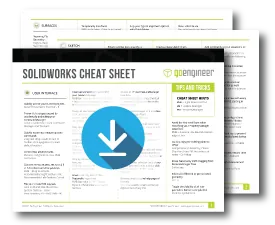Change Slot Orientation Using SOLIDWORKS Hole Wizard Feature
In Tech Support, we're often asked, “How do you change the orientation of a slot using the SOLIDWORKS Hole Wizard feature?”. While there are a few ways to do this, this blog will demonstrate one of the easiest methods. It will also show you how to link this orientation value to an equation for easily changing the angle.
There are three slot types within the Hole Wizard feature, located along the bottom of the options (from left to right: Counterbore Slot, Countersink Slot, Slot).

After selecting a slot type, determine the standard, size, fit, length, end conditions, etc. Once you have the options set for the slot, place the slot in the desired location.
To place the slot, select Positions at the top of the screen.

Select the face to add a slot to.

When you click the face, it will start a new sketch on that face, where you can start clicking and dropping Sketch Points, each defining the center of a slot. Multiple slots can be added if you keep clicking and adding points (shown below). When you've finished adding slot instances, de-select the Point tool to continue working with the sketch. Now you can drag the points around to re-position the instances, or delete any you don't need.

The very first slot placed has a line with it, which defines the length and angle of all the slots in this Slot Feature. Click and drag one of its endpoints to change the orientation of all of them.

You can also use standard relations and dimensioning to position the slots where needed. For instance, to make a single vertical slot centered within the face shown, I've removed the unneeded sketch points and added a vertical construction line to define a center point. A coincident relation between the center of the slot and the center point of the construction geometry defines the location, and a vertical relation to the slot line defines its orientation.

If you need to specify an angle for the slot(s), define an angle dimension between the slot line and the construction line you drew, instead of a vertical relation. To make it easier to modify the angle later, you can link it to a dimension specified in your equations, using Tools > Equations.

In this example, I created a Global Variable “A” and set it to 45 degrees. Next, set the angle dimension equal to the global variable.


Now, with the slot set and the angle tied to the global variable, you can change the angle from the Equations tab. For instance, to change the angle to 60 degrees now, follow the same steps above to open the Equations tab from the Tools menu. Then, change “A” to 60.

The slot will now automatically update to a 60-degree angle. If you ever need the slot to be vertical, horizontal, or at a specified angle, you no longer need to find and edit the Hole Wizard feature to set this. You can do it all from the Equations tab.

Horizontal at 90°

Vertical Set at 0°
Hopefully, this article will allow you to easily manipulate the orientation and positioning of slots within the Hole Wizard feature. Want to learn more? Check out more tutorials below. Additionally, check out the GoEngineer Community, where you can create forum posts, enter design contests, and answer questions from other SOLIDWORKS users.

SOLIDWORKS CAD Cheat Sheet
SHORTCUTS ⋅ MOUSE GESTURES ⋅ HOT KEYS
Our SOLIDWORKS CAD Cheat Sheet, featuring over 90 tips and tricks, will help speed up your process.
Related Articles
How to Fix Hole Wizard & Toolbox File Database Errors in SOLIDWORKS
How to Create Custom Cosmetic Threads in SOLIDWORKS
Missing Cosmetic Threads and How to Fix Them in SOLIDWORKS
Customizing the SOLIDWORKS Hole Callout File
About Dylan Funk
Dylan Funk is a Technical Support Engineer at GoEngineer.
Get our wide array of technical resources delivered right to your inbox.
Unsubscribe at any time.